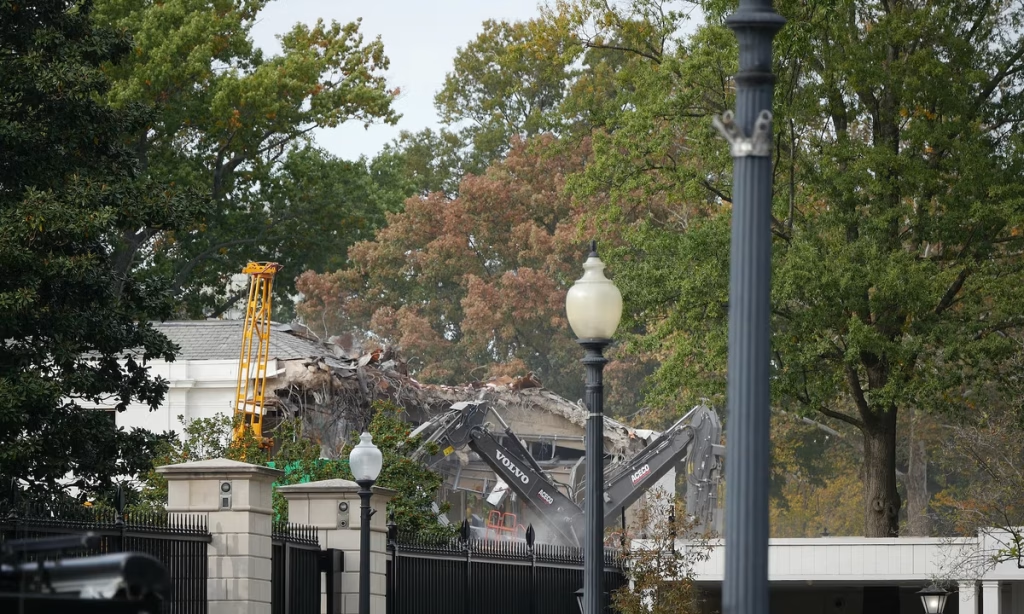Former real estate developer and current US president Donald J. Trump is no stranger to the thorny process of redeveloping a property. However, the property he recently decided to raze and rebuild is part of one of the most historically significant buildings in the country.
Last week, Trump had the East Wing of the White House completely demolished to make way for a $300m, 90,000-sq.-ft ballroom whose design and capacity keep changing. Images of the East Wing ripped apart by bulldozers and reduced to rubble have alarmed many historians and preservationists—and sparked at least one lawsuit—but Trump’s actions in this instance merely be brazen, rather than tests of established legal precedent.
While Section 106 of the National Historic Preservation Act requires any federal agency making renovations on a property to examine the impact of the renovations through a review process, Section 107 states that three buildings are exempt: the White House, the US Capitol and the US Supreme Court building. The White House and surrounding campus (officially “President’s Park”) are a national park and administered by the National Park Service.
Previous presidents have voluntarily submitted their plans for changes to the White House to the National Capital Planning Commission, which the Trump administration has not yet done. White House aide Will Scharf, who is in charge of the project as the chair of the National Capital Planning Commission (NCPC), has argued that planning approval is only needed for construction projects, not demolition, so tearing down the East Wing did not require oversight from the NCPC.
In response to the demolition Carol Quillen, the president and chief executive of the National Trust for Historic Preservation, issued statement that reads in part: “We acknowledge the utility of a larger meeting space at the White House, but we are deeply concerned that the massing and height of the proposed new construction will overwhelm the White House itself—it is 55,000 sq. ft—and may also permanently disrupt the carefully balanced classical design of the White House with its two smaller, and lower, East and West Wings.”
The White House has been expanded, renovated, remodelled and restored repeatedly, by many past presidents. The complex’s modern configuration is the product of a renovation by Theodore Roosevelt, which established the West Wing as the primary office space.
The East Wing of the White House shortly after its construction in 1902 Photo by Brady-Handy. Courtesy the Library of Congress
Franklin Delano Roosevelt subsequently expanded the East Wing into the social gathering site it became in the latter half of the 20th century. The East Wing housed the “family theatre” where John F. Kennedy watched the James Bond film From Russia with Love (1963) days before his assassination. It was home to the first lady’s office space and the Presidential Emergency Operations Center bunker, where presidents and their cabinets would hide during times of violence and coordinate their responses.
Kate Anderson Brower, the author of The Residence: Inside the Private World of the White House and First Women: The Grace & Power of America’s Modern First Ladies, said in an interview with CNN: “I certainly had a lot of reverence for [The East Wing] because it was the first lady’s domain. It’s the only place she has to really call her own.”
In a post on 24 October, the DC Preservation League, which advocates for care of historic buildings in US capital, wrote: “The demolition of the East Wing of the White House represents a collective loss—a serious affront to United States history and architectural heritage.” The post adds that “the White House has connected generations, and demolition without meaningful public input and review ruptures that continuity”.
The DC Preservation League’s post concludes: “Advocate for historic preservation, call for changes in policy and demand oversight of the architectural integrity of the White House to ensure that this significant legacy endures for future generations.”
The White House Historical Association, created in 1966 with support from first lady Jacqueline Kennedy, sought to strike a reassuring tone in a 22 October statement explaining that extensive digital and photographic cataloguing had been carried out before the jackhammers swept in.
“Upon announcement of the Ballroom construction project by the White House, the White House Historical Association supported the preservation of East Wing history through a comprehensive digital scanning project and photography to create an historic record,” the statement reads in part. “The East Wing and gardens have been captured in detail for the benefit of our nation and historic artifacts from the East Wing have been preserved and stored.”
Trump’s argument for demolishing the East Wing is that the White House needs a larger space for entertaining large crowds and the East Room—the largest room in the building—only has the capacity for 200 people. (He has been making this case since at least 2010.) His future ballroom will be significantly larger, holding 650, 999 or 1,350 people depending on which plans are ultimately used for construction. The project, whose budget has already grown by 50% since it was first announced, is being funded chiefly through donations from individuals and foundations who have long supported Trump, and a slew of companies that have business interests or regulatory matters with the federal government—including Amazon, Apple, Google, Meta, Microsoft, Palantir and Lockheed Martin.
Trump’s White House ballroom is expected to be complete before the end of his second term in January 2029. His previous alterations to the White House complex include turning the Rose Garden into a Mar-a-Lago-style patio and adding golden trim and other glimmering details to the Oval Office.
